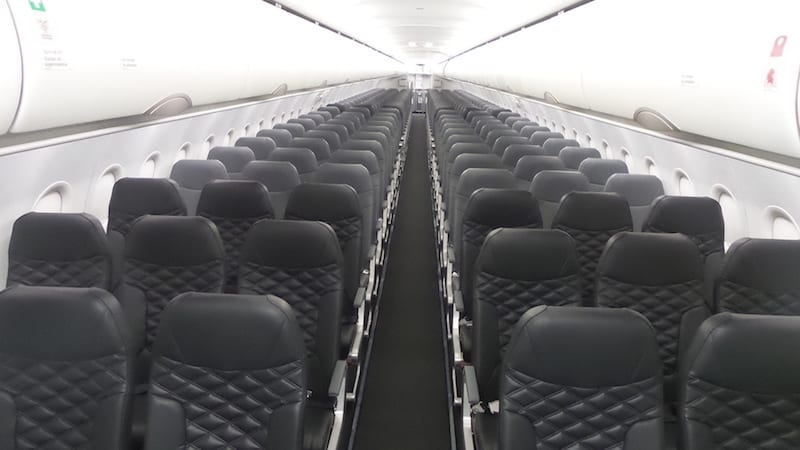
Frontier Airlines is still undecided on whether or not its future fleet of Airbus aircraft will feature in-flight entertainment and connectivity technology. Photo: Frontier Airlines
Frontier Airlines is in the midst of fleet refresh delivery schedule for 175 new Airbus A320neo family aircraft, including the A321XLR on track to join its fleet in 2024, however whether or not those new planes will feature in-flight entertainment and connectivity (IFEC) technology is not yet known.
Stephen Howell, a 30-year commercial airline industry veteran, took over as the senior director of in-flight experience at Frontier in August 2019. The ultra-low cost carrier currently operates a fleet of 43 total A320neo aircraft, none of which feature in-flight entertainment, Internet connectivity or in-seat power outlets.
“While we are continuously evaluating our in-flight offerings, it is important to note that Frontier is American’s Greenest Airline with a fleet that is 39 percent more fuel efficient, on average, than other U.S. carriers,” Howell told Avionics International in an emailed statement, referring to a September 2019 report published by the International Council on Clean Transportation (ICCT) which ranked Frontier as “America’s Greenest Airline.”
The report ranked Frontier as being the most fuel-efficient U.S. domestic operator in 2018, with Spirit Airlines and Southwest each tied for second, burning 7 percent more fuel to provide the same amount of service as Frontier. Alaska Airlines had previously been ranked the most fuel efficient U.S. domestic airline from 2010 to 2016. 2018 was Frontier’s second consecutive year holding the top spot.
Howell said weight savings achieved by not featuring seat-back IFE screens, modems, servers, wireless access points, antenna systems or the wiring and cabling needed to support IFEC technology is a major driver of efficiency for Frontier.
“A significant driver of our fuel efficiency is centered around aircraft weight. Lower aircraft weight saves fuel and reduces C02 emissions and it also helps reduce costs, ultimately benefiting our customers. The removal of in-flight entertainment devices plays a role in our weight-savings initiatives and, the fact is, the vast majority of Americans travel with a personal mobile device that provides them with their preferred entertainment choices,” Howell said.

Frontier is refreshing its fleet with a combined 175 total A320neos, pictured here, A321neos and A321XLRs. Photo: Frontier Airlines
Although airlines headquartered in North America feature the highest number of in-service aircraft featuring in-flight connectivity, – 80 percent of North America’s commercial active fleet features connectivity according to Valour Consultancy’s quarterly IFEC tracker – Frontier is not alone in featuring Internet-less flights. Other low cost carriers, including Las Vegas-based Allegiant Air and Minnesota’s Sun Country Airlines also currently have announced no plans to invest in connectivity.
Canadian leisure airline Air Transat also currently features no in-flight Wi-Fi access for passengers. After years of holding off on investment, Spirit Airlines became the first U.S.-based ultra low cost carrier to sign an agreement for in-flight connectivity under a May 2018 deal for the Thales FlytLIVE technology. Spirit has not yet released a timeline for going active with connectivity on passenger-carrying flights.

Part of Frontier’s strategy for keeping fares low includes a focus on not investing in IFEC, as it explicitly states on its website. Photo: Frontier Airlines
Howell said one area where Frontier is making an investment toward improving the in-flight experience is by extending the length of their initial flight attendant training program. Frontier is also introducing a new customer experience curriculum as part of their annual recurrent training program for flight attendants.
Over his career in the airline industry, Howell said the biggest change he has witnessed for the in-flight experience is a transition to “self service for passengers.”
 | Want to hear more on aircraft connectivity applications? Check out the Global Connected Aircraft Podcast, where Avionics editor-in-chief Woodrow Bellamy III interviews airlines and industry influencers on how they’re applying connectivity solutions. |
“When I began flying in the mid-1980s, we served caviar and expensive champagne in first class. Hot meals were provided on most every flight, regardless of the flying time, and we handed out magazines and newspapers. While those factors have changed, the inflight experience today continues to be first and foremost about the connection we make with our customers. Whether carving a roast in the aisle, or processing an onboard snack purchase, a welcoming and friendly experience is what customers will most remember and speak about with their family and friends. The biggest change I’ve witnessed in my career is the industry’s transition to a self-service travel environment. While many customers appreciate the use of technology to self-serve, at the same time, they still value positive interactions with airline employees. Flight attendants have an opportunity to create these interactions and create memorable travel experiences,” Howell said.
Correction: The article has been updated to clarify that Frontier Airlines has not decided yet whether or not their future Airbus A321XLR fleet will feature in-flight entertainment and connectivity technology.